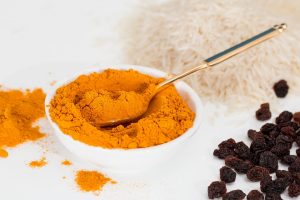Curcumin improves osteoarthritis inflammation and pain symptoms

Osteoarthritis is a progressive and degenerative disease of joints for which there is currently no cure. The most common treatment is with nonsteroidal anti-inflammatory drugs (NSAIDS) such as ibuprofen, naproxen, and diclofenac. These drugs have substantial stomach, kidney and cardiovascular side effects.
Curcumin is the main compound in turmeric. Several studies show curcumin protects cartilage via an anti-inflammatory, anti-oxidative stress and anti-catabolic effect.
This study caused injury to the knees of mice and then the mice were either fed cucumin or it was applied to their skin. The studies showed the mice treated with curcumin had significantly less inflammation based on staining and microscope analysis. Oral curcumin slowed disease progression but does not significantly help with pain. Topical curcumin slowed the progression of osteoarthritis in the mice and it also helped with symptoms. The thought is that oral curcumin does not accumulate in sufficient concentrations in the joint when taken orally.
The Research
Arthritis Res Ther. 2016 Jun 3;18(1):128. doi: 10.1186/s13075-016-1025-y.
Curcumin slows osteoarthritis progression and relieves osteoarthritis-associated pain symptoms in a post-traumatic osteoarthritis mouse model.
Zhang Z1,2,3, Leong DJ1,2, Xu L1,2, He Z1,2, Wang A1,2, Navati M4,5, Kim SJ1, Hirsh DM1, Hardin JA1, Cobelli NJ1, Friedman JM4,5, Sun HB6,7.
Abstract
BACKGROUND:
Curcumin has been shown to have chondroprotective potential in vitro. However, its effect on disease and symptom modification in osteoarthritis (OA) is largely unknown. This study aimed to determine whether curcumin could slow progression of OA and relieve OA-related pain in a mouse model of destabilization of the medial meniscus (DMM).
METHODS:
Expression of selected cartilage degradative-associated genes was evaluated in human primary chondrocytes treated with curcumin and curcumin nanoparticles and assayed by real-time PCR. The mice subjected to DMM surgery were orally administered curcumin or topically administered curcumin nanoparticles for 8 weeks. Cartilage integrity was evaluated by Safranin O staining and Osteoarthritis Research Society International (OARSI) score, and by immunohistochemical staining of cleaved aggrecan and type II collagen, and levels of matrix metalloproteinase (MMP)-13 and ADAMTS5. Synovitis and subchondral bone thickness were scored based on histologic images. OA-associated pain and symptoms were evaluated by von Frey assay, and locomotor behavior including distance traveled and rearing.
RESULTS:
Both curcumin and nanoparticles encapsulating curcumin suppressed mRNA expression of pro-inflammatory mediators IL-1β and TNF-α, MMPs 1, 3, and 13, and aggrecanase ADAMTS5, and upregulated the chondroprotective transcriptional regulator CITED2, in primary cultured chondrocytes in the absence or presence of IL-1β. Oral administration of curcumin significantly reduced OA disease progression, but showed no significant effect on OA pain relief. Curcumin was detected in the infrapatellar fat pad (IPFP) following topical administration of curcumin nanoparticles on the skin of the injured mouse knee. Compared to vehicle-treated controls, topical treatment led to: (1) reduced proteoglycan loss and cartilage erosion and lower OARSI scores, (2) reduced synovitis and subchondral plate thickness, (3) reduced immunochemical staining of type II collagen and aggrecan cleavage epitopes and numbers of chondrocytes positive for MMP-13 and ADAMTS5 in the articular cartilage, and (4) reduced expression of adipokines and pro-inflammatory mediators in the IPFP. In contrast to oral curcumin, topical application of curcumin nanoparticles relieved OA-related pain as indicated by reduced tactile hypersensitivity and improved locomotor behavior.
CONCLUSION:
This study provides the first evidence that curcumin significantly slows OA disease progression and exerts a palliative effect in an OA mouse model.
KEYWORDS:
ADAMTS5; Chondroprotection; Curcumin; MMPs; Nutraceuticals; Post-traumatic osteoarthritis











